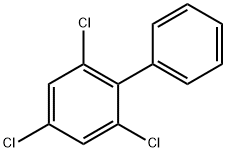35693-92-6

Product Name:
2,4,6-TRICHLOROBIPHENYL
Formula:
C12H7Cl3
Synonyms:
2,4,6-Trichlorobiphenyl solution
Inquiry
CHEMICAL AND PHYSICAL PROPERTIES
| Collision Cross Section | 149.6 Ų [M-Cl+O]- |
|---|---|
| Kovats Retention Index | 1721.7 1737 1745.6 1744.8 1742.1 1734.2 |
SAFETY INFORMATION
| Signal word | Danger |
|---|---|
| Pictogram(s) |
 Flame Flammables GHS02  Exclamation Mark Irritant GHS07  Health Hazard GHS08  Environment GHS09 |
| GHS Hazard Statements |
H225:Flammable liquids H304:Aspiration hazard H315:Skin corrosion/irritation H336:Specific target organ toxicity,single exposure; Narcotic effects H373:Specific target organ toxicity, repeated exposure H410:Hazardous to the aquatic environment, long-term hazard |
| Precautionary Statement Codes |
P210:Keep away from heat/sparks/open flames/hot surfaces. — No smoking. P260:Do not breathe dust/fume/gas/mist/vapours/spray. P331:Do NOT induce vomiting. P301+P310:IF SWALLOWED: Immediately call a POISON CENTER or doctor/physician. P370+P378:In case of fire: Use … for extinction. P403+P235:Store in a well-ventilated place. Keep cool. |
COMPUTED DESCRIPTORS
| Molecular Weight | 257.5 g/mol |
|---|---|
| XLogP3 | 5.7 |
| Hydrogen Bond Donor Count | 0 |
| Hydrogen Bond Acceptor Count | 0 |
| Rotatable Bond Count | 1 |
| Exact Mass | 255.961333 g/mol |
| Monoisotopic Mass | 255.961333 g/mol |
| Topological Polar Surface Area | 0 Ų |
| Heavy Atom Count | 15 |
| Formal Charge | 0 |
| Complexity | 189 |
| Isotope Atom Count | 0 |
| Defined Atom Stereocenter Count | 0 |
| Undefined Atom Stereocenter Count | 0 |
| Defined Bond Stereocenter Count | 0 |
| Undefined Bond Stereocenter Count | 0 |
| Covalently-Bonded Unit Count | 1 |
| Compound Is Canonicalized | Yes |
PRODUCT INTRODUCTION
description
2,4,6-Trichlorobiphenyl is one of 209 polychlorinated biphenyls (PCBs). PCBs are a group of synthetic organic compounds with 1-10 chlorine atoms attached to biphenyl. They were manufactured as commercial mixtures but banned in the 1970's because they were found to bioaccumulate and cause harmful health effects. However, PCBs do not break down readily and are still found in the environment. (L4)
